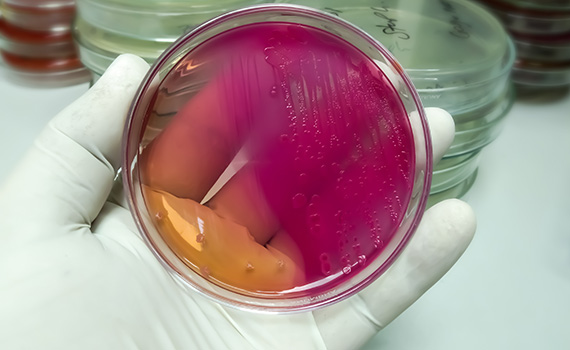Study indicates E. coli vaccine benefits broilers at high risk for infection

Immunizing broilers against Escherichia coli can yield a good return on investment in flocks confronted with a high challenge of the pathogen, indicate the results of a study.
Avian pathogenic E. colic (APEC) remains one of the most economically significant disease problems affecting the world’s broiler industry.1 It causes colibacillosis, characterized by a variety of conditions such as airsacculitis and cellulitis, which lead to condemnations. There are also substantial losses in productivity and, sometimes, high mortality in affected broilers.
The benefits of vaccination against E. coli are well established in long-lived birds such as layers but have been less consistently realized in broilers, possibly due to more varied challenge levels. As a result, a collaborative pen trial was conducted by Zoetis Inc. and Auburn University, says Kalen Cookson, DVM, director of clinical research for Zoetis.
Mimicking field conditions is the challenge
Investigators selected 1,600 broilers for the study and divided them into eight groups of 200 with eight replicates each.2 To mimic field conditions, they vaccinated all groups on day 1 of age with a vaccine that helps protect against infectious bronchitis and Newcastle disease, a practice that is common in the industry. Four of the groups also received Poulvac® E. coli, a modified-live vaccine containing E. coli. The vaccine is nonreactive, with a limited life span in the bird, but it provides macrophage and T-cell activation that helps protect against APEC, Cookson says.3
On day 28, investigators challenged six of the groups with APEC at different doses. Some groups received the challenge by eyedrop and intranasal administration and some by oral gavage. The remaining two groups served as controls: One was not vaccinated nor challenged, and one was vaccinated but not challenged (Table 1).

Figure 1. Effects of vaccination based on the percentage of broilers with airsacculitis scores ≥ 2 for all three test dates
Table 1. Study design
| Treatment groups | No. of birds in group* |
| Unvaccinated/not challenged (control) | 200 |
| Unvaccinated/low-dose respiratory challenge | 200 |
| Unvaccinated/high-dose respiratory challenge | 200 |
| Unvaccinated/high-dose crop challenge | 200 |
| E. coli vaccine/not challenged (control) | 200 |
| E. coli vaccine/low-dose respiratory challenge | 200 |
| E. coli vaccine/high-dose respiratory challenge | 200 |
| E. coli vaccine/high-dose crop challenge | 200 |
| TOTAL | 1,600 |
*Each group was divided into eight replicates of 25 birds each. Low dose = 106 colony-forming units (CFUs) administered. High dose = 109 CFUs administered. For the respiratory challenge, the dose of APEC was equally divided between the eye and nose.
The high-dose challenge administered in the eye and nose caused high levels of airsacculitis 5 days after challenge, validating the challenge method. The high-dose crop challenge caused levels of airsacculitis that were similar to the low-dose respiratory challenge, he says.
Investigators evaluated the birds on days 35, 42 and 49 to determine the impact of APEC challenge over time in vaccinated vs. unvaccinated birds. Compared to controls, broilers that were vaccinated against E. coli had significantly (p ≤ 0.05) decreased levels of airsacculitis after high-dose respiratory challenge. In addition, feed conversion and bodyweight were better and mortality was lower (Table 2) in the vaccinated, high-dose challenge groups, he reports.
Note: A score of 2 represented heavy suds or multifocal exudates, while 3 represented severe, profuse exudates.
Table 2. Performance results in vaccinated broilers compared to unvaccinated controls after challenge with a high-dose E. coli challenge (respiratory or gavage)
| Treatment | Final bodyweight (lbs) | Feed-conversion ratio | Percent mortality |
| Vaccinated | 7.958 | 2.0382 | 3.29 |
| Unvaccinated | 7.816 | 2.0687 | 4.56 |
“In the field, E. coli can be airborne, in which case birds inhale and aspirate the pathogen, or they get it in their eyes. This was mimicked by challenging birds in the eye and nose. E. coli can also be contracted by drinking it in water or eating litter, and this is what our crop challenge mimicked,” Cookson explains.
Producers should consider their broilers at high risk for E. coli infection if there has been a confirmed diagnosis of APEC infection on a farm or if there is a history of infectious bronchitis or Newcastle disease, which can predispose to E. coli disease. An increased rate of condemnations due to cellulitis or airsacculitis is another clue that E. coli infection may be a problem, he says.
“Our study indicates that for broilers at high risk of E. coli infection, vaccination against E. coli can be a tremendous help. We expect it to help provide a good return on investment in high-challenge situations by improving bodyweight and feed conversion and by decreasing mortality and condemnations,” Cookson says.
1. Shane, SM. Reducing pathogen E. coli infection by vaccination. Broilers. World Poultry. Updated October 14, 2010. http://www.worldpoultry.net/Broilers/Health/2009/12/Reducing-pathogenic-E-coli-infection-by-vaccination-WP006966W/ Accessed August 6, 2014.
2. Data on file, Study No. 221-13-70AQ0, Zoetis Inc.
3. Filho, T, et al. Effect of spray Escherichia coli vaccine on the immunity of poultry. Avian Diseases 57:671-676, 2013.
Posted on January 25, 2018
 We’re glad you’re enjoying
We’re glad you’re enjoying










